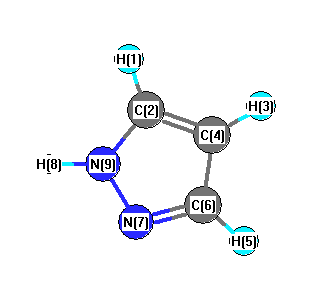Vibrational Frequencies calculated at CCD/6-31G*
| Mode Number |
Symmetry |
Frequency
(cm-1) |
Scaled Frequency
(cm-1) |
IR Intensities
(km mol-1) |
Raman Act
(Å4/u) |
Dep P |
Dep U |
|---|
| 1 |
A' |
3705 |
3506 |
85.45 |
|
|
|
| 2 |
A' |
3315 |
3137 |
0.55 |
|
|
|
| 3 |
A' |
3296 |
3119 |
2.58 |
|
|
|
| 4 |
A' |
3284 |
3108 |
4.34 |
|
|
|
| 5 |
A' |
1624 |
1537 |
6.67 |
|
|
|
| 6 |
A' |
1548 |
1465 |
9.55 |
|
|
|
| 7 |
A' |
1484 |
1404 |
18.94 |
|
|
|
| 8 |
A' |
1433 |
1356 |
4.75 |
|
|
|
| 9 |
A' |
1324 |
1253 |
2.49 |
|
|
|
| 10 |
A' |
1226 |
1160 |
1.60 |
|
|
|
| 11 |
A' |
1181 |
1118 |
19.07 |
|
|
|
| 12 |
A' |
1092 |
1034 |
23.17 |
|
|
|
| 13 |
A' |
1087 |
1029 |
17.04 |
|
|
|
| 14 |
A' |
956 |
905 |
4.78 |
|
|
|
| 15 |
A' |
936 |
886 |
8.21 |
|
|
|
| 16 |
A" |
864 |
818 |
14.46 |
|
|
|
| 17 |
A" |
818 |
774 |
6.56 |
|
|
|
| 18 |
A" |
753 |
713 |
89.76 |
|
|
|
| 19 |
A" |
700 |
662 |
22.69 |
|
|
|
| 20 |
A" |
631 |
597 |
0.01 |
|
|
|
| 21 |
A" |
510 |
482 |
64.00 |
|
|
|
Unscaled Zero Point Vibrational Energy (zpe) 15881.6 cm
-1
Scaled (by 0.9465) Zero Point Vibrational Energy (zpe) 15031.9 cm
-1
See section
III.C.1 List or set vibrational scaling factors
to change the scale factors used here.
See section
III.C.2
Calculate a vibrational scaling factor for a given set of molecules
to determine the least squares best scaling factor.
